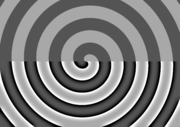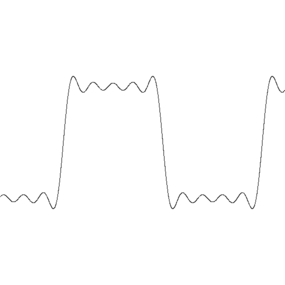
Acutance
Encyclopedia


Photography
Photography is the art, science and practice of creating durable images by recording light or other electromagnetic radiation, either electronically by means of an image sensor or chemically by means of a light-sensitive material such as photographic film...
, acutance is the edge contrast
Contrast (vision)
Contrast is the difference in visual properties that makes an object distinguishable from other objects and the background. In visual perception of the real world, contrast is determined by the difference in the color and brightness of the object and other objects within the same field of view...
of an image. Acutance is related to the amplitude of the derivative
Derivative
In calculus, a branch of mathematics, the derivative is a measure of how a function changes as its input changes. Loosely speaking, a derivative can be thought of as how much one quantity is changing in response to changes in some other quantity; for example, the derivative of the position of a...
of brightness with respect to space. Due to the nature of the human visual system, an image with higher acutance appears sharper even though an increase in acutance does not increase real resolution
Image resolution
Image resolution is an umbrella term that describes the detail an image holds. The term applies to raster digital images, film images, and other types of images. Higher resolution means more image detail....
.
In the example image, two light gray lines were drawn on a gray background. As the transition is instantaneous, the line is as sharp as can be represented at this resolution. Acutance in the left line was artificially increased by adding a 1 pixel wide darker border on the outside of the line and a 1 pixel wide brighter border on the inside of the line. The actual sharpness of the image has been decreased because the transition takes place across 4 pixels, but the apparent sharpness is increased because of the greater acutance.
Artificially increased acutance has drawbacks. In this somewhat overdone example most viewers will also be able to see the borders separately from the line, which create two halos around the line, one dark and one shimmering bright.
Tools
Several image processing techniques, such as unsharp maskingUnsharp masking
Unsharp masking is an image manipulation technique, often available in digital image processing software.The "unsharp" of the name derives from the fact that the technique uses a blurred, or "unsharp," positive to create a "mask" of the original image...
, can increase the acutance in real images.
Resampling

Low-pass filter
A low-pass filter is an electronic filter that passes low-frequency signals but attenuates signals with frequencies higher than the cutoff frequency. The actual amount of attenuation for each frequency varies from filter to filter. It is sometimes called a high-cut filter, or treble cut filter...
ing and resampling often cause overshoot
Overshoot (signal)
In signal processing, control theory, electronics, and mathematics, overshoot is when a signal or function exceeds its target. It arises especially in the step response of bandlimited systems such as low-pass filters...
, which increases acutance, but can also reduce absolute gradient, which reduces acutance. Filtering and resampling can also cause clipping
Clipping (audio)
Clipping is a form of waveform distortion that occurs when an amplifier is overdriven and attempts to deliver an output voltage or current beyond its maximum capability...
and ringing artifacts
Ringing artifacts
In signal processing, particularly digital image processing, ringing artifacts are artifacts that appear as spurious signals near sharp transitions in a signal. Visually, they appear as bands or "ghosts" near edges; audibly, they appear as "echos" near transients, particularly sounds from...
. An example is bicubic interpolation
Bicubic interpolation
In mathematics, bicubic interpolation is an extension of cubic interpolation for interpolating data points on a two dimensional regular grid. The interpolated surface is smoother than corresponding surfaces obtained by bilinear interpolation or nearest-neighbor interpolation...
, widely used in image processing
Image processing
In electrical engineering and computer science, image processing is any form of signal processing for which the input is an image, such as a photograph or video frame; the output of image processing may be either an image or, a set of characteristics or parameters related to the image...
for resizing images.
Definition
One definition of acutance is determined by imaging a sharp "knife-edge", producing an S-shaped distribution over a width W between maximum density D1 and minimum density D2 – steeper transitions yield higher acutance.Summing the slope Gn of the curve at N points within W gives the acutance value A,

Sharpness
Perceived sharpness is a combination of both resolutionOptical resolution
Optical resolution describes the ability of an imaging system to resolve detail in the object that is being imaged.An imaging system may have many individual components including a lens and recording and display components...
and acutance: it is thus a combination of the captured resolution, which cannot be changed in processing, and of acutance, which can be so changed.
Properly, perceived sharpness is the steepness of transitions (slope), which is change in output value divided by change in position – hence it is maximized for large changes in output value (as in sharpening filters) and small changes in position (high resolution).
Coarse grain
Film grain
Film grain or granularity is the random optical texture of processed photographic film due to the presence of small particles of a metallic silver, or dye clouds, developed from silver halide that have received enough photons. While film grain is a function of such particles it is not the same...
or noise
Image noise
Image noise is random variation of brightness or color information in images, and is usually an aspect of electronic noise. It can be produced by the sensor and circuitry of a scanner or digital camera...
can, like sharpening filters, increase acutance, hence increasing the perception of sharpness, even though they degrade the signal-to-noise ratio
Signal-to-noise ratio
Signal-to-noise ratio is a measure used in science and engineering that compares the level of a desired signal to the level of background noise. It is defined as the ratio of signal power to the noise power. A ratio higher than 1:1 indicates more signal than noise...
.
The term is sometimes heard (by analogy with critical focus
Critical focus
In a photograph, the area of critical focus is the portion of the picture that is optically in focus. This does not relate to depth of field which describes apparent sharpness....
) for "obtaining maximal optical resolution", as limited by the sensor/film and lens, and in practice means minimizing camera shake – using a tripod
Tripod (photography)
In photography, a tripod is used to stabilize and elevate a camera, or to support flashes or other photographic equipment. All photographic tripods have three legs and a mounting head to couple with a camera...
or alternative support, mirror lock-up
Mirror lock-up
Mirror lock-up is a feature employed in many Single Lens Reflex cameras. It allows the operator to reduce vibration-induced motion blur during exposure...
, a cable release or timer, image stabilizing
Image stabilization
Image stabilization is a family of techniques used to reduce blurring associated with the motion of a camera during exposure. Specifically, it compensates for pan and tilt of a camera or other imaging device. It is used in image-stabilized binoculars, still and video cameras, and astronomical...
lenses – and optimal aperture for the lens and scene, usually 2–3 stops down from wide-open (more for deeper scenes: balances off diffraction blur with defocus blur or lens limits at wide-open).
See also
- Contrast (vision)Contrast (vision)Contrast is the difference in visual properties that makes an object distinguishable from other objects and the background. In visual perception of the real world, contrast is determined by the difference in the color and brightness of the object and other objects within the same field of view...
- Cornsweet illusionCornsweet illusionThe Cornsweet illusion, also known as Craik–O'Brien–Cornsweet illusion and Craik–Cornsweet illusion, is an optical illusion that was described in detail by Tom Cornsweet in the late 1960s...
- Edge enhancementEdge enhancementEdge enhancement is an image processing filter that enhances the edge contrast of an image or video in an attempt to improve its acutance ....
- Mach bandsMach bandsMach bands is an optical illusion named after the physicist Ernst Mach. The illusion consists of light or dark stripes that are perceived next to the boundary between two regions of an image that have different lightness gradients .-Explanation:The Mach bands effect is due to the spatial...
- Ringing artifact
External links
- Tutorials: Sharpness, at Cambridge in Colour
- Understanding Sharpness, at The Luminous Landscape
- Lens Sharpness: The Never-Ending Quest, at The Luminous Landscape

